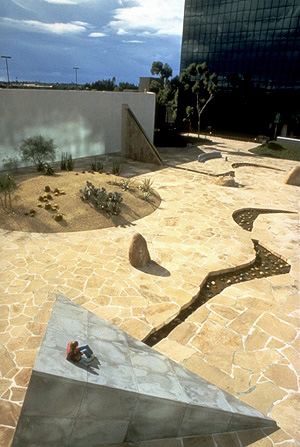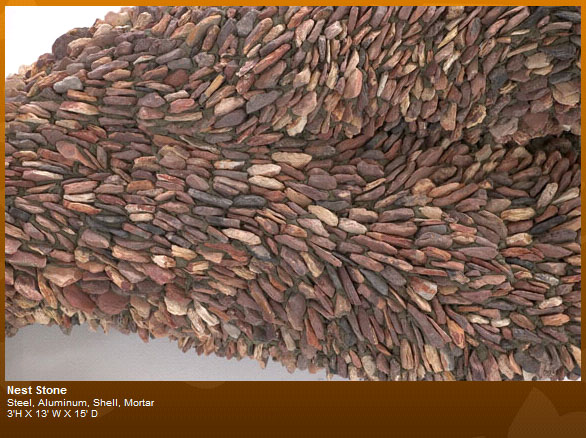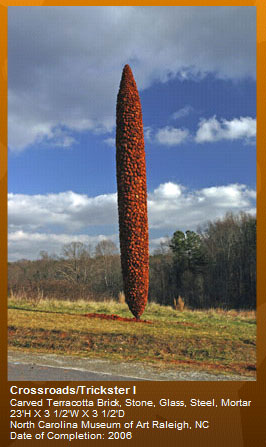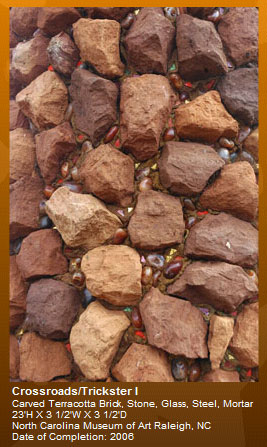Sculptures of Spring '08
Emily Bzdyk
Project 4- Self Designed
ARTIST RESEARCH and Bibliography

Sources:
The Isamu Noguchi Garden Museum by Isamu Noguchi Harry N. Abrams, Inc., Publishers, New York 1987
http://www.noguchi.org/badesign.html
http://www.fostertravel.com/CANOGU.html
Isamu Noguchi was a Japanese-American sculpture who is considered one of the most influential and important of the twentieth century. He studied with Brancusi and his works appear all across the world. He fused western modernism with aesthetic of Japan in his quest to find sculptural space, for the lived environment. He designed works that would be useful in everyday life, such as slide and playgrounds, or his famous coffee table design which is as popular today as ever. Later in his life he created great works of granite and basalt in abstract forms for outdoor gardens and spaces. Space was one of his biggest interests, and how space could be used in sculpture, or be sculpted and used by people.
He created twenty gardens, plazas and parks, including “California Scenario”, a park with symbolic elements that represent the topography of the state of his birth. He considered the gardens as works as a whole, not simply places with objects in them. These projects allowed him to come to a better understanding of nature and stone as a material and element. His work moved toward stone continuously throughout his life. He enjoyed the finality and endurance of stone sculpture, despite the difficulty of carving it.
In The Isamu Noguchi Garden Museum in New York, there is a vast array of Noguchi’s works on display. Many of his stone sculptures have a column like stature of the original block, with smoothed marks on their surface. Other works exhibit geometric or organic abstract forms. There are many smoothed variations of rings and loops such as “The Bow” “downward pulling” and “the Void”. The more organic forms of “young mountain, and “Emergent” These are explorations of form where objects “in transit from one state to another”
These last two works seem to me to have similar goals to that of my sculpture. Physically and superficially, they have the same soft rounded shapes that my pebble/time/change/growth sculpture has. But also, I think the goals of the works as explorations of material have a similar concept that my work does. While I’m not trying to carve stone, my ideas come from nonphysical concepts of geologic time, lifetime, but also from the stones themselves. The stone have a story, they travel from their place of origin and are eroded by the tools of time, water, and earth. Ice of glaciers, water of lakes, rivers, streams, or simply earth, sand, or other stones round and leave their mark on them. This is the basis for the design of the form. The pebbles are again quoted as a material in surfacing. Noguchi was much more intimately connected with the stone in that it was his influence and his material, in a very pure way.

Another of his works, which I feel relates in some ways to my work, is “California Scenario” This is a park, 1.6 acres of land between two office buildings. It is a special sculpture, composed of the area and the elements of sculpture placed within it. Noguchi considered space as a material and the park is a unified piece. He created it to reflect the topography and characteristics of the state of California. There are carefully chosen plants placed in the environment, and geometric and simplified forms that represent various aspects of California. The sandstone “Water source” and “water use” are related to my work in that it has the water falling as a physical design. My sculpture quotes water flowing from mountains, and rock and pebbles are moved and eroded by glacial activity. My piece is as much about the pebbles and geology as about the land I live in. The pebbles I will use come from places I have lived. Coincidently, I am moving to California, so this work pertains to my thoughts as I work to integrate California’s pebbles into the pebbles of my current home of St. Mary’s. Also long island is a glacial moraine, the island exists because of glacial activity depositing till on the coast.
One of the biggest differences between these two works is that I don’t see my sculpture as a functional item, it is a pure result of an organic design representing time, change, growth, fueled by geological concepts of erosion. It is also an object, meant to stand alone as a work, whereas the “California Scenario” is an entire environment. Noguchi also was fond of creating large scale site works such as parks and gardens. My ambitions are not nearly as large scale
Sources:
Sculpture Magazine. Jan/Feb 04 Vol 22 No.1. Martha Jackson-Jarvis: The Process of Discovery by Curtia James
http://www.jacksonjarvisstudio.com/
Martha Jarvis Jackson is a sculptor based in Washington DC. For over 30 years, she has worked in mixed media, including mosaics and collages, which incorporate metals, clay, glass, stone, and many other materials. Her works have been commissioned in many public arenas, and she has installations and exhibitions all along the east coast of the United States. Her works are inspired by her familial ties, her enthusiasm for cooking and enthrallment with the possibilities of clay. Her major installations “Music of the Spheres” and “River Spirits of the Anacostia” are in Washington DC. The former consists of several large spheres, surfaced with mosaic; the later is a large 400-foot glass mosaic panel running around the top four and a half feet of all four sides of the Anacostia station. These works contrast the urban environment that they are situated in. Jarvis Jackson incorporates many themes into her work, including energy, spontaneity, light, death, and life. Culture figures largely in her work as well, with many references to African American history and experience. She uses the history of people and places as a source for inspiration.
“Music of the spheres” is situated outside a metro station. There are seven spheres, ranging in size from 10 feet to 4 feet in diameter. They are encrusted with jade pebbles, glass and other materials. The spheres are huge and create a compelling interactive space for passerbies on the sidewalk. They create an element of mystical fantasy and contemplation in the urban landscape.
Her mosaics tell a story through use of representative imagery. River Spirits of the Anacostia is a large mosaic featuring animals, fish, plants and other figures which represent the essence of life and souls of the river and all those that live there. These more representational works use a narrative element to tell the story of the river, uniting past, present and future

Her sculptures are rich in color and texture, and her collage and works on paper explode with exciting forms and patterns. She developed her sculpting technique simultaneously with painting which helped her deal with the surface of sculptures. “Nest stone” is a large meandering form covered in stone mortar. There are several wispy and shriveled organic figures, connected by sinewy cords of sticklike nature. In terms of surfacing, this work is very similar to mine.

In North Carolina Museum of Art there is “Crossroads/Trickster I” This large work seems to defy gravity as it balances along the side of a road. It is a rod-like pinnacle, tapered at the ends. The work is 23 feet high, and 3 feed in diameter. The surface is ornately decorated with rough rock pieces and also colorful glass pebble shapes hidden in the cracks. Jarvis Jackson’s uses of organic and abstract shapes, as well as her utilization of the mosaic as a surfacing process are all concepts strongly reflected in my work. Theses works and mine are immediately and obviously comparable. My goals as an artist are also similar in that I am integrating a personal story with this piece. It is an abstraction of geological processes, erosion and growth over time. I cannot know exactly what Jarvis- Jackson’s intension are for each of her abstracted works, but I can see that the organic forms and intimate relationship with nature are themes that I share as well.

“Ochum” Earth Mounds” is an installation at the South Carolina Botanical gardens. It is composed of Adobe, river sand, moss, ferns and wood. There are a series of orangey clay mounds integrated into the forest floor. There are also other natural elements that have been tinkered with, in a very ‘Andy Goldsworthy’ kind of way. Martha Jarvis Jackson uses nature as a source and materials in a similar way that I do. I have also enjoyed experimenting with natural materials out in the environment which they belong. If I were creating this piece as an installation, I would choose a site that enhanced it’s meaning, such as a shoreline of a pebbly beach, or lake. Water is a key component to my work, but is unaddressed by the piece itself in any direct way.
St. Mary's College of Maryland
St. Mary's City MD 20686-3001
Back to Index
This page was last updated: April 21, 2008 1:17 PM